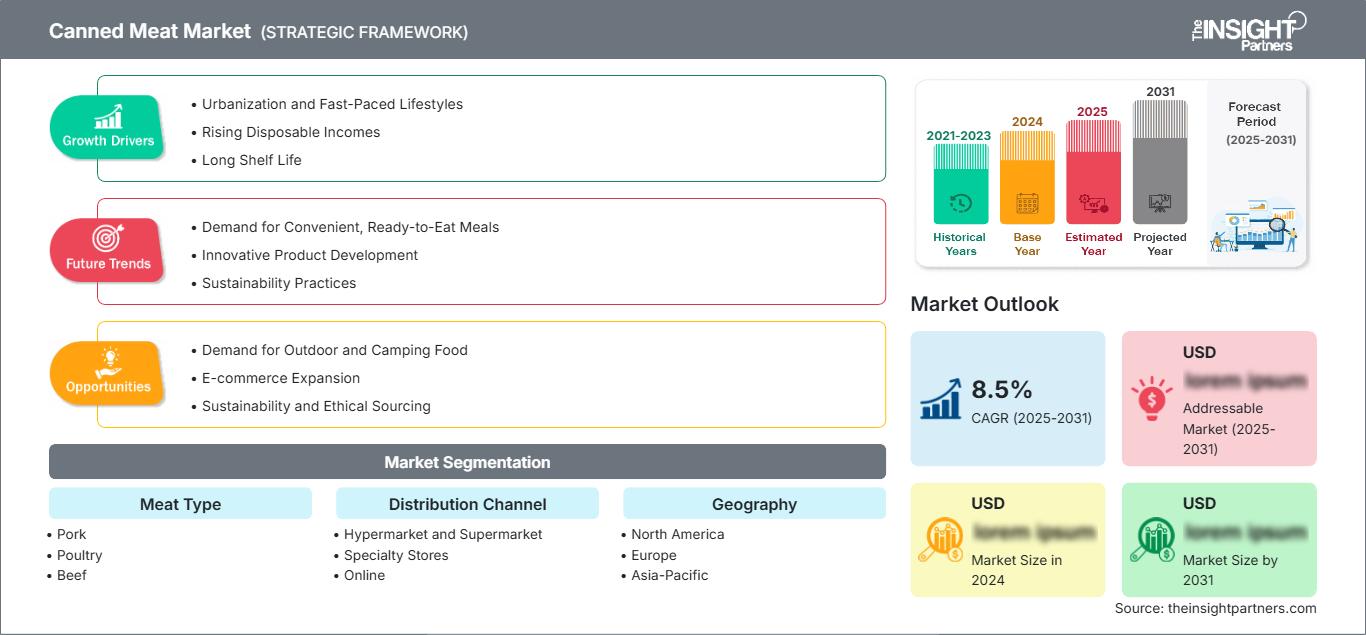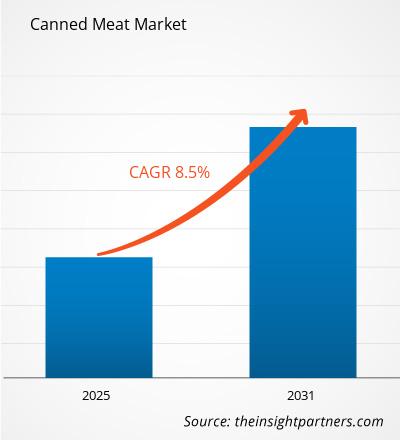Se prevé que el mercado de carne enlatada registre una tasa de crecimiento anual compuesta (TCAC ) del 8,5% entre 2025 y 2031, con un tamaño de mercado que se expandirá de XX millones de dólares estadounidenses en 2024 a XX millones de dólares estadounidenses en 2031.
El informe de investigación de mercado de carne enlatada se segmenta por tipo de carne en los siguientes subsegmentos : cerdo, pollo, res y mariscos. El informe también proporciona un análisis basado en el canal de distribución, es decir , hipermercados y supermercados, tiendas especializadas y venta en línea. El análisis global se desglosa a nivel regional y por países principales. La valoración del mercado se presenta en dólares estadounidenses para el análisis segmentado mencionado .
Finalidad del informe
El informe sobre el mercado de carne enlatada, elaborado por The Insight Partners, tiene como objetivo describir el panorama actual y el crecimiento futuro, los principales factores impulsores, los desafíos y las oportunidades. Esto proporcionará información valiosa a diversos actores del sector, tales como:
- Proveedores/fabricantes de tecnología: Para comprender la evolución de la dinámica del mercado y conocer las posibles oportunidades de crecimiento, lo que les permitirá tomar decisiones estratégicas informadas.
- Inversores: Realizar un análisis exhaustivo de las tendencias relativas a la tasa de crecimiento del mercado, las proyecciones financieras del mercado y las oportunidades que existen a lo largo de la cadena de valor.
- Organismos reguladores: Regular las políticas y controlar las actividades en el mercado con el objetivo de minimizar los abusos, preservar la confianza de los inversores y mantener la integridad y la estabilidad del mercado.
Segmentación del mercado de carne enlatada
Tipo de carne
- Cerdo
- Aves de corral
- Carne de res
- Mariscos
Canal de distribución
- Hipermercado y supermercado
- Tiendas especializadas
- En línea
Obtendrá personalización gratuita de cualquier informe, incluyendo partes de este informe, análisis a nivel de país y paquetes de datos de Excel. Además, podrá aprovechar excelentes ofertas y descuentos para empresas emergentes y universidades.
Mercado de carne enlatada: Perspectivas estratégicas

- Obtenga las principales tendencias clave del mercado que se describen en este informe.Esta muestra GRATUITA incluirá análisis de datos, que abarcarán desde tendencias de mercado hasta estimaciones y pronósticos.
Factores que impulsan el crecimiento del mercado de carne enlatada
- Urbanización y estilos de vida acelerados: La creciente urbanización y los estilos de vida acelerados están impulsando la demanda de opciones de alimentos convenientes y listos para consumir, como la carne enlatada.
- Aumento de la renta disponible: El aumento de la renta disponible en las economías emergentes está ampliando el acceso a una mayor variedad de productos alimenticios, incluida la carne enlatada.
- Larga vida útil: La larga vida útil de la carne enlatada la convierte en una opción popular para la preparación ante emergencias y las actividades al aire libre, lo que impulsa su demanda.
- Alternativas más saludables: Los fabricantes ofrecen opciones de carne enlatada más saludables, incluyendo productos bajos en sodio y orgánicos, para satisfacer a los consumidores preocupados por su salud.
Tendencias futuras del mercado de carne enlatada
- Demanda de comidas prácticas y listas para consumir: La creciente demanda de comidas prácticas y listas para consumir entre los millennials y la generación Z es un factor clave para el mercado de la carne enlatada.
- Desarrollo de productos innovadores: Los fabricantes están creando nuevos productos cárnicos enlatados gourmet con perfiles de sabor y texturas únicos para atraer a los consumidores que buscan novedades.
- Prácticas de sostenibilidad: La adopción de envases ecológicos y prácticas de abastecimiento responsable está cobrando cada vez más importancia, lo que refleja el interés de los consumidores por la sostenibilidad.
- Proteínas de origen vegetal y alternativas: Los fabricantes que respondan al creciente interés por las fuentes de proteínas de origen vegetal y alternativas pueden acceder a nuevos segmentos de consumidores y fomentar el crecimiento del mercado.
Oportunidades de mercado para la carne enlatada
- Demanda de alimentos para actividades al aire libre y acampada: La creciente tendencia de las actividades al aire libre y la acampada está impulsando la demanda de alimentos portátiles, ligeros y duraderos, como la carne enlatada.
- Expansión del comercio electrónico: El rápido crecimiento del sector del comercio electrónico presenta una oportunidad para que los productos cárnicos enlatados lleguen a un público más amplio a través de las ventas en línea.
- Sostenibilidad y abastecimiento ético: El creciente enfoque en la sostenibilidad y el abastecimiento ético ofrece a los productores la oportunidad de posicionar sus productos como respetuosos con el medio ambiente, atrayendo a los consumidores "ecológicos".
Perspectivas regionales del mercado de carne enlatada
Los analistas de The Insight Partners han explicado detalladamente las tendencias y los factores regionales que influyen en el mercado de carne enlatada durante el período de previsión. Esta sección también analiza los segmentos y la geografía del mercado de carne enlatada en Norteamérica, Europa, Asia Pacífico, Oriente Medio y África, y Sudamérica y Centroamérica.
Alcance del informe sobre el mercado de carne enlatada
| Atributo del informe | Detalles |
|---|---|
| Tamaño del mercado en 2024 | XX millones de dólares estadounidenses |
| Tamaño del mercado para 2031 | XX millones de dólares estadounidenses |
| Tasa de crecimiento anual compuesto global (2025 - 2031) | 8,5% |
| Datos históricos | 2021-2023 |
| período de previsión | 2025-2031 |
| Segmentos cubiertos | Por tipo de carne
|
| Regiones y países cubiertos | América del norte
|
| Líderes del mercado y perfiles de empresas clave |
|
Densidad de los actores del mercado de carne enlatada: comprensión de su impacto en la dinámica empresarial
El mercado de carne enlatada está creciendo rápidamente, impulsado por la creciente demanda del consumidor final debido a factores como la evolución de las preferencias del consumidor, los avances tecnológicos y una mayor conciencia de los beneficios del producto. A medida que aumenta la demanda, las empresas amplían su oferta, innovan para satisfacer las necesidades del consumidor y aprovechan las nuevas tendencias, lo que impulsa aún más el crecimiento del mercado.

- Obtenga una visión general de los principales actores del mercado de carne enlatada.
Puntos clave de venta
- Cobertura integral: El informe abarca de forma exhaustiva el análisis de productos, servicios, tipos y usuarios finales del mercado de carne enlatada, proporcionando una visión holística.
- Análisis de expertos: El informe se elabora a partir del profundo conocimiento de expertos y analistas del sector.
- Información actualizada: El informe garantiza su relevancia para el negocio gracias a su cobertura de información reciente y tendencias de datos.
- Opciones de personalización: Este informe se puede personalizar para satisfacer las necesidades específicas del cliente y adaptarse adecuadamente a las estrategias comerciales.
Por lo tanto, el informe de investigación sobre el mercado de carne enlatada puede ayudar a impulsar la comprensión del panorama de la industria y sus perspectivas de crecimiento. Si bien existen algunas preocupaciones válidas, los beneficios generales de este informe tienden a superar las desventajas.
- Análisis histórico (2 años), año base, pronóstico (7 años) con CAGR
- Análisis PEST y FODA
- Tamaño del mercado, valor/volumen: global, regional y nacional
- Industria y panorama competitivo
- Conjunto de datos de Excel
Informes recientes
Informes relacionados
Testimonios
Razón para comprar
- Toma de decisiones informada
- Comprensión de la dinámica del mercado
- Análisis competitivo
- Información sobre clientes
- Pronósticos del mercado
- Mitigación de riesgos
- Planificación estratégica
- Justificación de la inversión
- Identificación de mercados emergentes
- Mejora de las estrategias de marketing
- Impulso de la eficiencia operativa
- Alineación con las tendencias regulatorias




















 Obtenga una muestra gratuita para - Mercado de carne enlatada
Obtenga una muestra gratuita para - Mercado de carne enlatada